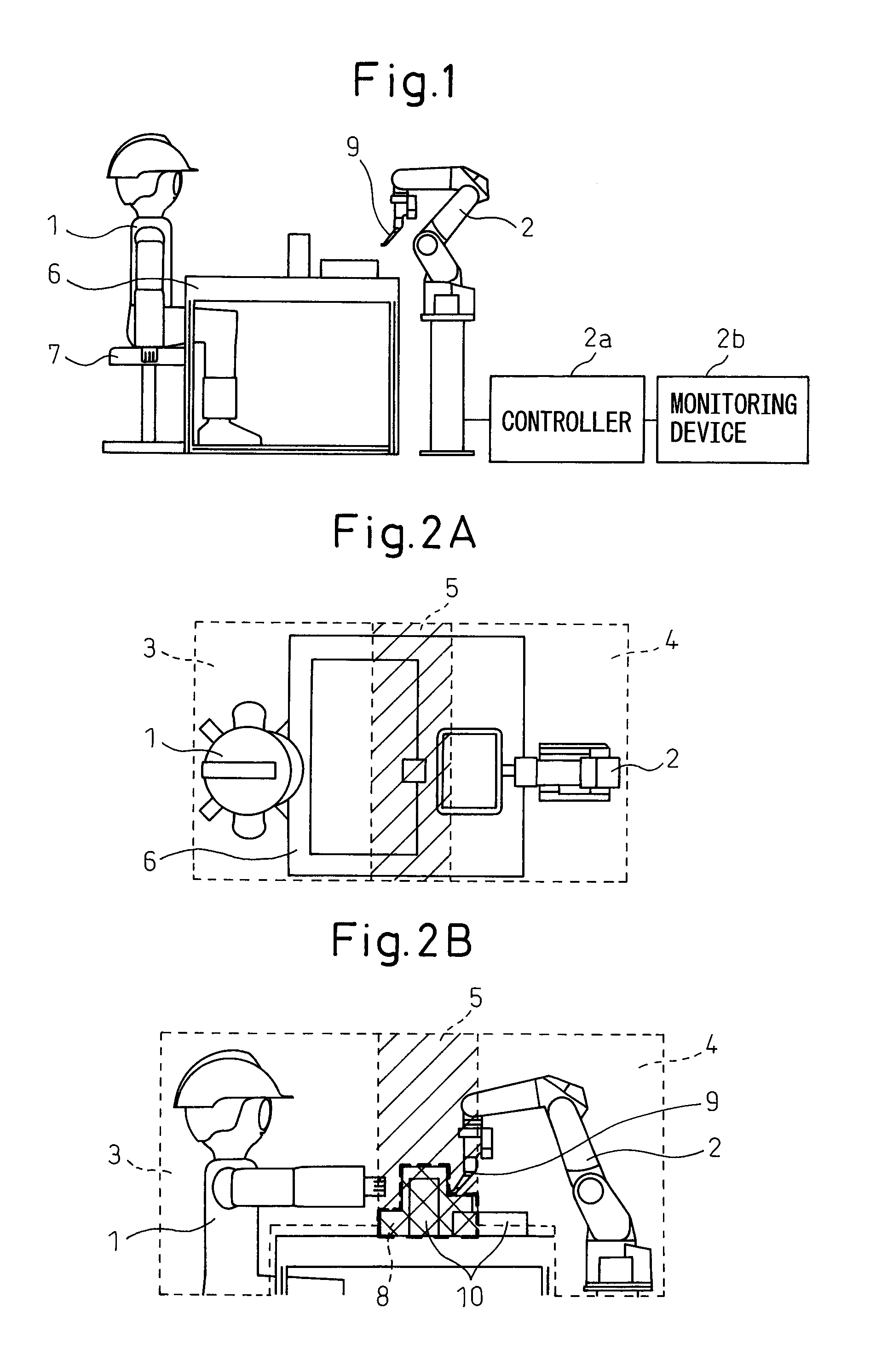Production system having cooperating process area between human and robot
a technology of production system and process area, which is applied in the direction of electric programme control, program control, instruments, etc., can solve the problems of reducing the robot's efficiency, reducing the robot's work efficiency, and so as to reduce the robot's speed and prevent serious injuries. , the effect of reducing the robot's speed
- Summary
- Abstract
- Description
- Claims
- Application Information
AI Technical Summary
Benefits of technology
Problems solved by technology
Method used
Image
Examples
first embodiment
[0043]As shown in FIG. 1, in a production system according to a first embodiment, a working table 6 is arranged. A robot 2 is positioned at one side of working table 6. A seat 7 for an operator 1 is positioned at the other side of working table 6.
[0044]Although robot 2 is illustrated in FIG. 1 as a general multijoint robot having a component, such as a hand 9, capable of gripping a workpiece and / or a work tool, attached to the front end of the robot, robot 2 may be a robot having another conventional configuration. Since the detail of the robot does not directly relate to the present invention, explanation thereof is omitted. Robot 2 has a controller 2a, which controls a driving part of robot 2 such as a drive motor of a link mechanism, so as to control the motion of robot 2.
[0045]In any case, robot 2 is adapted to perform a task such as processing and / or transferring a workpiece on or above working table 6. A movement range of robot 2 is defined so that the movement range does not ...
second embodiment
[0057]When it is not necessary that the operator and the robot perform a cooperative task, area 5 as described above may be defined as an area where only the operator or the robot may perform a task. In this case, the limitation of the maximum speed of the robot is not necessary, whereby the production efficiency of the system may be improved. However, since both the operator and the robot may enter area 5, it is necessary to avoid the serious collision between the operator and the robot within area 5. Hereinafter, a second embodiment for solving the problem is explained.
[0058]The second embodiment as shown in FIG. 4 is a modification of the first embodiment. In FIG. 4, each element similar to that of FIG. 1 has the same reference numeral. Further, some of components of a production system similar to those of FIG. 1 are not illustrated, and a detailed explanation thereof is omitted.
[0059]In a production system of the second embodiment, depending on the situation, cooperative task ar...
third embodiment
[0070]A third embodiment as shown in FIGS. 5 to 7 is a modification of the first embodiment. In FIGS. 5 to 7, each element similar to that of FIG. 1 has the same reference numeral. Further, some of components of a production system similar to those of FIG. 1 are not illustrated, and detailed explanation thereof is omitted.
[0071]In a production system according to the third embodiment, a safety fence 15, configured to limit an area where operator 1 can enter, is positioned between operator 1 and robot 2. Safety fence 15 has a window 16, whereby a hand of operator 1 can reach a robot side area where robot 2 is arranged through window 16.
[0072]As shown in FIG. 6, an operator side area in relation to safety fence 15 is determined as operator task area 3. The component of robot 4 is configured not to pass through window 16, by determining the size of the arm of the robot and / or limiting the movable range of the link mechanism of the robot.
[0073]On the robot side area in relation to safet...
PUM
 Login to View More
Login to View More Abstract
Description
Claims
Application Information
 Login to View More
Login to View More - R&D
- Intellectual Property
- Life Sciences
- Materials
- Tech Scout
- Unparalleled Data Quality
- Higher Quality Content
- 60% Fewer Hallucinations
Browse by: Latest US Patents, China's latest patents, Technical Efficacy Thesaurus, Application Domain, Technology Topic, Popular Technical Reports.
© 2025 PatSnap. All rights reserved.Legal|Privacy policy|Modern Slavery Act Transparency Statement|Sitemap|About US| Contact US: help@patsnap.com



